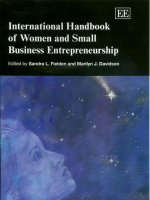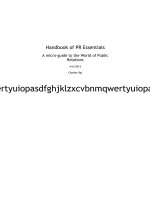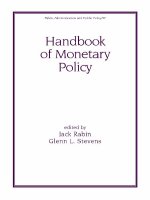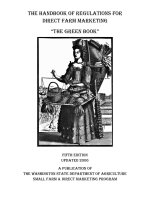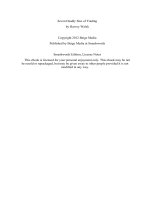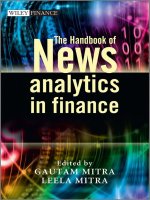handbook of trading strategies - gregoriou 2010
Bạn đang xem bản rút gọn của tài liệu. Xem và tải ngay bản đầy đủ của tài liệu tại đây (4.56 MB, 497 trang )
The
H
ANDBOOK
of
T
RADING
Other McGraw-Hill Books Edited by Greg N. Gregoriou
The Credit Derivatives Handbook: Global Perspectives, Innovations, and Market
Drivers (2008, with Paul U. Ali)
The Handbook of Credit Portfolio Management (2008, with Christian Hoppe)
The Risk Modeling Evaluation Handbook (2010, with Christian Hoppe and
Carsten S. Wehn)
The VaR Implementation Handbook (2009)
The VaR Modeling Handbook: Practical Applications in Alternative Investing,
Banking, Insurance, and Portfolio Management (2009)
The
H
ANDBOOK
of
T
RADING
New York Chicago San Francisco
Lisbon London Madrid Mexico City
Milan New Delhi San Juan Seoul
Singapore Sydney Toronto
STRATEGIES FOR NAVIGATING
AND PROFITING FROM CURRENCY,
BOND, AND STOCK MARKETS
Greg N. Gregoriou
Editor
Copyright © 2010 by The McGraw-Hill Companies, Inc. All rights reserved. Except as permitted
under the United States Copyright Act of 1976, no part of this publication may be reproduced or
distributed in any form or by any means, or stored in a database or retrieval system, without the prior
written permission of the publisher.
ISBN: 978-0-07-174354-9
MHID: 0-07-174354-5
The material in this eBook also appears in the print version of this title: ISBN: 978-0-07-174353-2,
MHID: 0-07-174353-7.
All trademarks are trademarks of their respective owners. Rather than put a trademark symbol after
every occurrence of a trademarked name, we use names in an editorial fashion only, and to the benefi t
of the trademark owner, with no intention of infringement of the trademark. Where such designations
appear in this book, they have been printed with initial caps.
McGraw-Hill eBooks are available at special quantity discounts to use as premiums and sales
promotions, or for use in corporate training programs. To contact a representative please e-mail us at
This publication is designed to provide accurate and authoritative information in regard to the subject
matter covered. It is sold with the understanding that neither the author nor the publisher is engaged in
rendering legal, accounting, futures/securities trading, or other professional service. If legal advice or
other expert assistance is required, the services of a competent professional person should be sought.
—From a Declaration of Principles jointly adopted by a Committee of the American Bar Association
and a Committee of Publishers
TERMS OF USE
This is a copyrighted work and The McGraw-Hill Companies, Inc. (“McGrawHill”) and its licensors
reserve all rights in and to the work. Use of this work is subject to these terms. Except as permitted
under the Copyright Act of 1976 and the right to store and retrieve one copy of the work, you may
not decompile, disassemble, reverse engineer, reproduce, modify, create derivative works based upon,
transmit, distribute, disseminate, sell, publish or sublicense the work or any part of it without McGraw-
Hill’s prior consent. You may use the work for your own noncommercial and personal use; any other
use of the work is strictly prohibited. Your right to use the work may be terminated if you fail to comply
with these terms.
THE WORK IS PROVIDED “AS IS.” McGRAW-HILL AND ITS LICENSORS MAKE NO
GUARANTEES OR WARRANTIES AS TO THE ACCURACY, ADEQUACY OR COMPLETE-
NESS OF OR RESULTS TO BE OBTAINED FROM USING THE WORK, INCLUDING ANY
INFORMATION THAT CAN BE ACCESSED THROUGH THE WORK VIA HYPERLINK OR
OTHERWISE, AND EXPRESSLY DISCLAIM ANY WARRANTY, EXPRESS OR IMPLIED, INCLUD-
ING BUT NOT LIMITED TO IMPLIED WARRANTIES OF MERCHANTABILITY OR FITNESS
FOR A PARTICULAR PURPOSE. McGraw-Hill and its licensors do not warrant or guarantee that the
functions contained in the work will meet your requirements or that its operation will be uninterrupted
or error free. Neither McGraw-Hill nor its licensors shall be liable to you or anyone else for any
inaccuracy, error or omission, regardless of cause, in the work or for any damages resulting therefrom.
McGraw-Hill has no responsibility for the content of any information accessed through the work.
Under no circumstances shall McGraw-Hill and/or its licensors be liable for any indirect, incidental,
special, punitive, consequential or similar damages that result from the use of or inability to use the
work, even if any of them has been advised of the possibility of such damages. This limitation of
liability shall apply to any claim or cause whatsoever whether such claim or cause arises in contract,
tort or otherwise.
CONTENTS
EDI TOR xvii
CONTRIBUTORS xix
ACK NOWLEDGMENTS xxxiii
PART
I EXECUTION AND MOMENTUM TR ADING 1
CHAPTER
1 Performance Leakage and Value
Discounts on the Toronto
Stock Exchange 3
Lawrence Kryzanowski and Skander Lazrak
Abstract 3
Introduction 4
Sample and Data 5
Measures of Performance Leakage and Value Discounts 5
Empirical Estimates for the TSX 7
Conclusion 18
Acknowledgments 18
References 19
Notes 20
CHAPTER
2 Informed Trading in Parallel
Auction and Dealer Markets:
The Case of the London
Stock Exchange 23
Pankaj K. Jain, Christine Jiang, Thomas H. McInish, and
Nareerat Taechapiroontong
Abstract 23
Introduction 23
Trading Systems and Venues 24
Institutional Background, Data, and Methodology 27
v
Empirical Results 30
Conclusion 35
Acknowledgments 36
References 36
Notes 38
CHAPTER
3 Momentum Trading for the
Private Investor 39
Alexander Molchanov and Philip A. Stork
Abstract 39
Introduction 39
Data 40
Momentum Trading Results 41
Robustness Tests 45
Trading with a Volume Filter 47
Private Investor Trading 49
Conclusion 50
Acknowledgments 51
References 51
Notes 52
CHAPTER
4 Trading in Turbulent Markets:
Does Momentum Work? 53
Tim A. Herberger and Daniel M. Kohlert
Abstract 53
Introduction 53
Literature Review 54
Data and Methodology 55
Results 57
Conclusion 62
References 63
Notes 65
CHAPTER
5 The Financial Futures Momentum 67
Juan Ayora and Hipòlit Torró
Abstract 67
Introduction 67
Literature Review 68
vi contents
Data 69
Methodology and Results 69
Conclusion 77
Acknowledgments 79
References 79
Notes 80
CHAPTER
6 Order Placement Strategies in
Different Market Structures:
A Primer 83
Giovanni Petrella
Abstract 83
Introduction 83
Costs and Benefits of Limit Order Trading 84
Trading in a Continuous Order-Driven Market 86
Trading in a Call Auction 89
Conclusion 91
References 92
PART
II TECHNICAL TR ADING 95
CHAPTER
7 Profitability of Technical
Trading Rules in an Emerging
Market 97
Dimitris Kenourgios and Spyros Papathanasiou
Abstract 97
Introduction 98
Methodology 100
Data and Empirical Results 103
Conclusion 108
References 109
Notes 111
CHAPTER
8 Testing Technical Trading Rules
as Portfolio Selection Strategies 113
Vlad Pavlov and Stan Hurn
Introduction 113
contents vii
Data 115
Portfolio Formation 116
Bootstrap Experiment 122
Conclusion 124
Acknowledgments 126
References 126
Notes 127
CHAPTER
9 Do Technical Trading Rules
Increase the Probability of
Winning? Empirical Evidence
from the Foreign Exchange
Market 129
Alexandre Repkine
Abstract 129
Introduction 130
Empirical Methodology 131
Empirical Results 135
Conclusion 139
References 140
CHAPTER
10 Technical Analysis in
Turbulent Financial Markets:
Does Nonlinearity Assist? 141
Mohamed El Hedi Arouri, Fredj Jawadi, and Duc Khuong Nguyen
Abstract 141
Introduction 142
Nonlinear Modeling for Technical Analysis 143
Data and Empirical Results 147
Conclusion 150
References 150
Notes 153
CHAPTER
11 Profiting from the Dual-Moving
Average Crossover with
Exponential Smoothing 155
Camillo Lento
Abstract 155
viii contents
Introduction 156
Background on the Moving Averages 157
Methodology 159
Data 161
Trading with the Exponentially
Smoothed DMACO 162
Conclusion 167
References 168
Notes 170
CHAPTER
12 Shareholder Demands and the
Delaware Derivative Action 171
Edward Pekarek
Abstract 171
Introduction 171
Policy Purposes for Derivative Actions 173
Demand Requirements 174
Standing to Sue Derivatively 178
Futility Excuses the Demand Requirement 179
Futility, Director Independence, and Business
Judgment 180
Conclusion 181
Acknowledgments 182
References 183
PART
III EXCHANGE-TR ADED FUND STR ATEGIES 187
CHAPTER
13 Leveraged Exchange-Traded
Funds and Their Trading
Strategies 189
Narat Charupat
Abstract 189
Introduction 189
Trading Strategies 190
Conclusion 197
References 197
Notes 197
contents ix
CHAPTER
14 On the Impact of Exchange-
Traded Funds over Noise
Trading: Evidence from
European Stock Exchanges 199
Vasileios Kallinterakis and Sarvinjit Kaur
Abstract 199
Introduction 199
Data 201
Methodology 201
Descriptive Statistics 204
Results; Conclusion 204
References 211
Notes 211
CHAPTER
15 Penetrating Fixed-Income
Exchange-Traded Funds 213
Gerasimos G. Rompotis
Abstract 213
Introduction 213
Methodology 215
Data and Statistics 217
Empirical Results 220
Conclusion 229
References 231
CHAPTER
16 Smooth Transition Autoregressive
Models for the Day-of-the-Week
Effect: An Application to the
S&P 500 Index 233
Eleftherios Giovanis
Abstract 233
Introduction 233
Literature Review 234
Methodology 235
Data 238
Empirical Results 239
Conclusion 249
References 250
x contents
PART
IV FOREIGN EXCHANGE MARKETS,
ALGORITHMIC TR ADING, AND RISK 253
CHAPTER
17 Disparity of USD Interbank
Interest Rates in Hong Kong
and Singapore: Is There Any
Arbitrage Opportunity? 255
Michael C. S. Wong and Wilson F. Chan
Abstract 255
Introduction 255
HIBOR and SIBOR 256
Data And Findings 257
Explanations for the HIBOR-SIBOR Disparity 259
Conclusion 260
References 261
CHAPTER
18 Forex Trading Opportunities
Through Prices Under Climate
Change 263
Jack Penm and R. D. Terrell
Abstract 263
Introduction 263
Methodology 267
Data and Empirical Application 271
Conclusion 274
References 274
CHAPTER
19 The Impact of Algorithmic
Trading Models on the
Stock Market 275
Ohannes G. Paskelian
Abstract 275
Introduction 276
The Impact of Algorithmic Trading on the Market 277
Algorithmic Strategies 279
Algorithmic Trading Advantages 281
Algorithmic Trading Beyond Stock Markets 282
contents xi
Conclusion 282
References 283
CHAPTER
20 Trading in Risk Dimensions 287
Lester Ingber
Abstract 287
Introduction 287
Data 288
Exponential Marginal Distribution Models 288
Copula Transformation 289
Portfolio Distribution 293
Risk Management 294
Sampling Multivariate Normal Distribution 295
Conclusion 297
References 298
CHAPTER
21 Development of a Risk-
Monitoring Tool Dedicated
to Commodity Trading 301
Emmanuel Fragnière, Helen O’Gorman, and Laura Whitney
Abstract 301
Introduction 301
Literature Review 303
Methodology 305
Conclusion 313
Resources 314
PART
V TR ADING VOLUME AND BEHAVIOR 317
CHAPTER
22 Securities Trading, Asymmetric
Information, and Market
Transparency 319
Mark D. Flood, Kees G. Koedijk, Mathijs A. van Dijk, and
Irma W. van Leeuwen
Abstract 319
Introduction 320
xii contents
Experimental Design and Terminology 323
Data 326
Results 328
Conclusion 337
Acknowledgments 338
References 339
Notes 341
CHAPTER
23 Arbitrage Risk and the High-
Volume Return Premium 343
G. Geoffrey Booth and Umit G. Gurun
Abstract 343
Introduction 343
Data and Method 344
Tests 346
Conclusion 348
References 349
CHAPTER
24 The Impact of Hard versus Soft
Information on Trading Volume:
Evidence from Management
Earnings Forecasts 351
Paul Brockman and James Cicon
Abstract 351
Introduction 352
Data and Methodology 353
Empirical Results 356
Conclusion 361
References 362
CHAPTER
25 Modeling Bubbles and
Anti-Bubbles in Bear Markets:
A Medium-Term Trading
Analysis 365
Dean Fantazzini
Abstract 365
Introduction 365
contents xiii
Log-Periodic Models: A Review 367
Empirical Analysis with World Stock Market Indexes 372
Out-of-Sample Empirical Analysis 381
Conclusion 387
References 387
CHAPTER
26 Strategic Financial
Intermediaries with
Brokerage Activities 389
Laurent Germain, Fabrice Rousseau, and Anne Vanhems
Abstract 389
Introduction 390
The Benchmark Model: No Noise Is Observed 392
The General Model: When Some Noise Is Observed 394
Conclusion 398
References 398
Appendix 399
CHAPTER
27 Financial Markets, Investment
Analysis, and Trading in
Primary and Secondary
Markets 403
André F. Gygax
Abstract 403
Introduction 404
Investment Analysis and Types of Trading 404
Composition of Trading Volume and Trading 406
Trading in Primary Versus Secondary Markets 407
Conclusion 412
References 412
CHAPTER
28 Trading and Overconfidence 417
Ryan Garvey and Fei Wu
Abstract 417
Introduction 417
Data 418
xiv contents
Empirical Results 420
Conclusion 425
References 426
Notes 427
CHAPTER
29 Correlated Asset Trading and
Disclosure of Private
Information 429
Ariadna Dumitrescu
Abstract 429
Introduction 429
The Model 433
Disclosure of Information and Market Liquidity 436
Conclusion 440
Acknowledgments 440
References 440
INDEX 443
contents xv
This page intentionally left blank
xvii
EDI TOR
Greg N. Gregoriou has published 38 books, 60 refereed publications in
peer-reviewed journals, and 20 book chapters since his arrival at SUNY
(Plattsburgh) in August 2003. Professor Gregoriou’s books have been pub-
lished by John Wiley & Sons, McGraw-Hill, Elsevier-Butterworth/
Heinemann, Taylor and Francis/CRC Press, and Palgrave-Macmillan. His
articles have appeared in the Journal of Portfolio Management, Journal
of Futures Markets, European Journal of Operational Research, Annals of
Operations Research, Computers and Operations Research, and elsewhere. Pro-
fessor Gregoriou is hedge fund editor and an editorial board member for
the Journal of Derivatives and Hedge Funds, as well as an editorial board
member for the Journal of Wealth Management, the Journal of Risk Manage-
ment in Financial Institutions, and the Brazilian Business Review. He is also a
member of the curriculum committee at Chartered Alternative Investment
Analyst (CAIA) Association based in Amherst, Massachusetts. A native of
Montreal, Professor Gregoriou obtained his joint Ph.D. in finance at the
University of Quebec at Montreal, which merges with the resources of
Montreal’s three other major universities (McGill University, Concordia
University, and HEC-Montreal). Professor Gregoriou’s interests focus on
hedge funds and CTAs.
This page intentionally left blank
xix
CONTRIBUTORS
Mohamed El Hedi Arouri is an associate professor of finance at the
University of Orleans, France and a researcher at EDHEC Business School
in France. He holds a master’s degree in economics and a Ph.D. in finance
from the University of Paris X Nanterre. His research focuses on the cost
of capital, stock market integration, and international portfolio choice. He
has published articles in refereed journals such as the International Journal
of Business and Finance Research, Frontiers of Finance and Economics, the
Annals of Economics and Statistics, Finance, and Economics Bulletin.
Juan Ayora is an investment manager. He obtained a degree in actuarial
and financial Studies (2006) and the MSc in banking and quantitative
finance (2008), both with honors from the University of Valencia, Spain.
His areas of interest focus on portfolio management and trading rules.
G. Geoffrey Booth holds the Frederick S. Addy Distinguished Chair in
Finance, serves as the Department of Finance Chairperson, and is the
Acting Associate Dean for Academic Affairs and Research at Michigan
State University. He received his Ph.D. from the University of Michigan
in 1971. Professor Booth’s research focuses on the behavior of financial
markets. He serves on several editorial boards and is the editor of the
Journal of International Financial Markets, Institutions & Money.
Paul Brockman is the Joseph R. Perella and Amy M. Perella Chair of
Finance at Lehigh University. He holds a bachelor’s degree in international
studies from Ohio State University (summa cum laude), an MBA from
Nova Southeastern University (accounting minor), and a Ph.D. in finance
(economics minor) from Louisiana State University. He received his Certi-
fied Public Accountant (CPA) designation (Florida, 1990) and worked for
several years as an accountant, cash manager, and futures and options
trader. His academic publications have appeared in the Journal of Finance,
the Journal of Financial Economics, the Journal of Financial and Quantitative
Analysis, the Journal of Banking and Finance, the Journal of Corporate
Finance, the Journal of Empirical Finance, the Journal of Financial Research,
Financial Review, Review of Quantitative Finance and Accounting, and Finan-
cial Markets, Institutions and Instruments, among others. Professor Brock-
man has served as a member of the editorial board for the Journal of
Multinational Financial Management and the Hong Kong Securities Insti-
tute’s Securities Journal.
Wilson F. Chan is an assistant general manager of Shanghai Commercial
Bank, a former assistant general manager and head of Treasury & Markets
of Industrial and Commercial Bank of China (Asia), and a former director
of Citi Private Bank. He has 20 years’ experience in currency and interest
rate trading, and holds the degrees MA, MSocSci, and MBA. Mr. Chan had
served as the secretary of ACI–Hong Kong Financial Markets Association
for more than 10 years. In 2005, the association was merged into Treasury
Markets Association, where he leads its education subcommittee.
Narat Charupat is an associate professor of finance at the DeGroote
School of Business, McMaster University. He has conducted research in the
areas of financial innovation, security designs, annuity and insurance prod-
ucts, commodity investment, and behavioral finance. His research has been
published in various journals such as the Journal of Economic Theory, the
Journal of Banking and Finance, the Journal of Risk and Insurance, and the
Journal of Financial and Quantitative Analysis (forthcoming). He has taught
courses in financial derivatives, international finance, and personal finance.
Prior to joining McMaster University, he worked for an investment bank
and a risk management software company.
James Cicon holds a law degree ( JD) and an MBA from the University of
Missouri. Prior to returning to school for his joint JD/MBA he was an elec-
trical and computer engineer (Brigham Young University) and worked many
years modeling, simulating, and designing new products for companies,
such as Hewlett Packard and Fluke. Mr. Cicon has written hundreds of
thousands of lines of code and debugged codebases with millions of lines.
Some of the new products he developed include drivers and hardware for
inkjet printers, ATM and Frame Relay wide area network analyzers, and
industrial/automotive monitoring and protection systems. He has written
neural network software enabling Pepsico to place Taco Bell restaurant sites
and he has designed adaptive controllers which learn how to best control
brain slice chambers used in biomedical research. Mr. Cicon served four
years in the U.S. Military Intelligence Corp and worked live missions in the
iron curtain in Germany gathering and processing information from East-
ern bloc countries. At the time of this writing, Mr. Cicon is a Ph.D. candi-
date in the finance department of the University of Missouri. He has
presented twice at FMA and has several working papers based on latent
semantic analysis and textual analysis of corporate documents.
xx contributors
Ariadna Dumitrescu holds a Ph.D. in economics from IDEA (Universitat
Autònoma de Barcelona), and a bachelor’s degree in mathematics from the
University of Bucharest. She is an assistant professor of finance at ESADE
Business School, France. Her research interests include asset pricing and
strategic behavior in financial markets, with applications to market microstruc-
ture and valuation of corporate debt. Her research results have been published
in leading field journals such as the Journal of Corporate Finance, the Journal of
Banking and Finance, and European Financial Management.
Dean Fantazzini is an associate professor in econometrics and finance at
the Moscow School of Economics–Moscow State University (MSU), a
trainer at the Academy of Business–Ernst & Young in Moscow and, since
September 2009, a visiting professor in econometrics and finance at the
Higher School of Economics, Moscow. He graduated with honors from the
Department of Economics at the University of Bologna (Italy) in 2000. He
obtained the master in financial and insurance investments from the
Department of Statistics–University of Bologna (Italy) in 2000 and a Ph.D
in economics in 2006 from the Department of Economics and Quantitative
Methods, University of Pavia (Italy). Before joining the Moscow School of
Economics, he was a research fellow at the Chair for Economics and
Econometrics, University of Konstanz (Germany) and at the Department of
Statistics and Applied Economics, University of Pavia (Italy). A specialist in
time-series analysis, financial econometrics, multivariate dependence in
finance and economics, Professor Fantazzini has to his credit more than 20
publications, including three monographs. In 2009 he was awarded for
fruitful scientific research and teaching activities by the former USSR Pres-
ident and Nobel Peace Prize winner Mikhail S. Gorbachev and by the MSU
Rector Professor Viktor A. Sadovnichy.
Mark D. Flood completed his undergraduate work at Indiana University
in Bloomington, where he majored in finance (B.S., 1982) and German and
economics (B.A., 1983). In 1990, he received his Ph.D. in finance from the
Graduate School of Business at the University of North Carolina at Chapel
Hill. He was a visiting scholar and economist in the research department of
the Federal Reserve Bank of St. Louis from 1989 to 1993. From 1993 to
2003, he served as an assistant professor of finance at Concordia University
in Montreal, a visiting assistant professor of finance at the University of
North Carolina at Charlotte, and a senior financial economist in the Divi-
sion of Risk Management at the Office of Thrift Supervision. He is a senior
financial economist at the Federal Housing Finance Agency in Washington,
DC; a partner with RiskTec Currency Management, which markets
contributors xxi
currency funds; and the co-founder of ProBanker Simulations, which sells
educational simulations of a banking market. His research interests include
financial markets and institutions, data integration technologies, securities
market microstructure, and bank market structure and regulatory policy.
His research has appeared in a number of scholarly journals, including the
Review of Financial Studies, Quantitative Finance, the Journal of International
Money and Finance, and the St. Louis Fed’s Review.
Emmanuel Fragnière is a Certified Internal Auditor and a professor of
service management at the Haute École de Gestion in Geneva, Switzerland.
He is also a lecturer at the Management School of the University of Bath,
UK. He specializes in energy, environmental, and financial risk. He has
published several papers in academic journals such as the Annals of Opera-
tions Research, Environmental Modeling and Assessment, Interfaces, the Inter-
national Journal of Enterprise Information Systems, and Management Science.
Ryan Garvey is an associate professor in finance and chair of the Depart-
ment of Finance at Duquesne University, Pittsburgh, PA. Professor Garvey’s
research has been published in the Journal of Financial Markets, Financial
Analysts Journal, Journal of Portfolio Management, Journal of Empirical
Finance, and many other journals. He has devised intraday trading models
implemented by a U.S. broker-dealer.
Laurent Germain is a professor of finance and the head of the Finance
Group at Toulouse Business School, France. His research interests include
market microstructure, behavioral finance, and corporate finance. He grad-
uated from Toulouse Business School, Toulouse School of Economics, New
York University, and the University Paris Dauphine. After a post-doctorate
from London Business School in 1996 financed by the European Commis-
sion, he attained a position of assistant professor of finance at London Busi-
ness School. He left LBS in 2000 to join Toulouse Business School. He is
one of the directors of the European Financial Management Association
and has published articles in leading journals such as the Review of Financial
Studies, the Journal of Financial and Quantitative Analysis, and the Journal of
Financial Intermediation.
Eleftherios Giovanis studied economics at the University of Thessaly
(Volos-Greece) and graduated in July 2003. He went on to graduate with an
MSc in applied economics and finance at the University of Macedonia
(Thessaloniki-Greece) in 2009. Mr. Giovanis complete a second MSc in
quality assurance at the Hellenic Open University in Patra, Greece, at the
xxii contributors
School of Technology & Science. His dissertation is on reliability and
maintenance analysis. He also works as a statistician for a well-known
Greek firm.
Umit G. Gurun joined the University of Texas at Dallas as an assistant
professor of accounting in August 2004, after receiving his Ph.D. in finance
from Michigan State University. Professor Gurun also holds an MBA from
Koc University of Turkey, and a bachelor’s degree in industrial engineering
from Bilkent University of Turkey. His research interests are in the areas of
asset pricing, market microstructure, and investments.
André F. Gygax (lic.oec.HSG St.Gallen; MS, MBA Colorado; Ph.D. Mel-
bourne) is a faculty member at the University of Melbourne in Australia.
He has published research articles in the areas of corporate finance, entre-
preneurial finance, and asset pricing. Professor Gygax has worked for the
University of Colorado and the University of Technology in Sydney. He
has also worked in the corporate sector for Swiss Bank Corporation, Busag
Ventures, Mercis, the World Trade Center, and Micrel.
Tim A. Herberger is a Ph.D. candidate as well as a research and teaching
assistant in finance at the department of management, business administra-
tion, and economics at Bamberg University (Germany). He studied business
administration at the University of Erlangen-Nuernberg (Germany), and at
the University of St. Gallen (Switzerland). He received his MSc in 2007.
His major fields of research are behavioral and empirical finance as well as
investments in human capital.
A. Stan Hurn graduated with a D.Phil. in economics from Oxford in
1992. He worked as a lecturer in the Department of Political Economy at
the University of Glasgow from 1988 to 1995 and was appointed Official
Fellow in Economics at Brasenose College, Oxford in 1996. In 1998 he
joined the Queensland University of Technology as a professor in the
School of Economics and Finance. His main research interests are in the
field of time-series econometrics. He is foundation board member of
the National Centre for Econometric Research.
Lester Ingber received his diploma from Brooklyn Technical High School
in 1958; a bachlor’s degree in physics from Caltech in 1962; and a Ph.D. in
theoretical nuclear physics from the University of California, San Diego in
1966. He has published approximately 100 papers and books in theoretical
nuclear physics, neuroscience, finance, general optimization, combat analysis,
contributors xxiii
karate, and education. He has held positions in academia, government, and
industry. Through Lester Ingber Research (LIR), he develops and consults
on projects documented in his Webste ( archive).
Pankaj K. Jain is the Suzanne Downs Palmer Associate Professor of
Finance at the Fogelman College of Business at the University of Memphis.
Previously he worked in the financial services industry. He has published
his award-winning research on financial market design in leading journals
such as the Journal of Finance, the Journal of Banking and Finance, Financial
Management, the Journal of Investment Management, the Journal of Financial
Research, and Contemporary Accounting Research. He has been invited to
present his work at the New York Stock Exchange, National Stock
Exchange of India, National Bureau of Economic Research in Cambridge,
and the Capital Market Institute at Toronto.
Fredj Jawadi is currently an assistant professor at Amiens School of
Management and a researcher at EconomiX at the University of Paris
Ouest Nanterre La Defense (France). He holds a master’s degree in
econometrics and a Ph.D. in financial econometrics from the University
of Paris X Nanterre (France). His research topics cover modeling asset
price dynamics, nonlinear econometrics, international finance, and finan-
cial integration in developed and emerging countries. He has published in
international refereed journals such as the Journal of Risk and Insurance,
Applied Financial Economics, Finance, and Economics Bulletin, as well as
authoring several book chapters.
Christine Jiang is a professor of finance at the Fogelman College of Busi-
ness and Economics at the University of Memphis, Tennessee. Professor
Jiang’s research includes issues in market microstructure, investments, and
international finance. She has made numerous presentations at national and
international conferences. She has published articles on market microstruc-
ture, exchange rates, mutual fund performance, and asset pricing in the
Journal of Finance, the Journal of Banking and Finance, Financial Analysts
Journal, Decision Science, the Journal of Financial Research, Financial Review,
and other refereed journals. Her work has been featured in articles in the
Financial Times and Dow Jones News Service. Winner of the Suzanne
Downs Palmer Professorship in Research in 2003 and 2006 at the Univer-
sity of Memphis, Professor Jiang earned her Ph.D. in finance from Drexel
University in Philadelphia, PA. She also holds a master’s degree from the
Sloan School of Management of the Massachusetts Institute of Technology,
and a bachelor’s of science from Fudan University in Shanghai, China.
xxiv contributors
